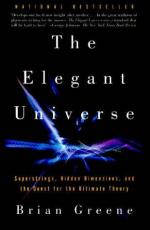
|
| Name: _________________________ | Period: ___________________ |
This quiz consists of 5 multiple choice and 5 short answer questions through Chapter Ten, Quantum Geometry.
Multiple Choice Questions
1. In quantum mechanics, what is symmetry breaking?
(a) The primary reason that the theory is incompatible with general relativity.
(b) When an asymmetrical matter and anti-matter pair is created.
(c) When the symmetry between a electrical and magnetic field is broken at high energy levels.
(d) When two fused fundamental forces become separated out.
2. Which of the follow is true of objects with which string theory is concerned?
(a) They include strings and other objects as well.
(b) The objects are purely imaginary.
(c) They are all really Calabi-Yau shapes.
(d) It concerns one-dimensional strings and nothing else.
3. Which physicist is credited with discovering that light is composed of particles?
(a) Rutherford.
(b) Planck.
(c) Maxwell.
(d) Einstein.
4. According to Einstein's theory of general relativity, if two objects have a gravitational pull on one another, and one changes its mass or distance from the other, how quickly does the effect of this change travel to the other object?
(a) Near the speed of light, faster for more massive objects.
(b) Instantaneously.
(c) At exactly the speed of light.
(d) Near the speed of light, faster for lighter objects.
5. What property of electromagnetic waves did Max Planck solve the thermodynamic problem of the oven by discovering?
(a) Waves are really particles.
(b) There are infinite numbers of waves, but each has an infinitely small energy.
(c) They can penetrate or "tunnel" through any surface.
(d) They have a minimum energy, proportional to their frequency.
Short Answer Questions
1. Two theories form the basis of modern physics, but are incompatible with one another. String theory attempts to reconcile these fields. What are these two theories?
2. Which of the following did Einstein considered time?
3. According to string theory, which of the following cannot occur during the collapse of the universe?
4. In which particle was spin first discovered?
5. How are the amplitude of a string's vibration and the mass of the particle it represents related?
|
This section contains 418 words (approx. 2 pages at 300 words per page) |

|




